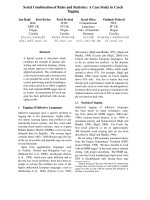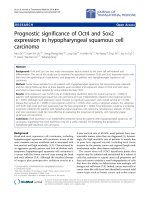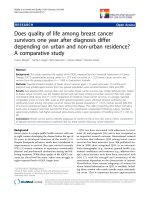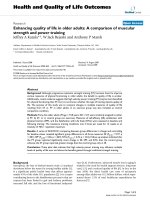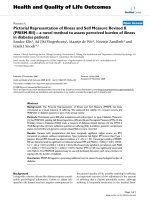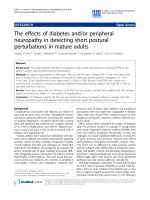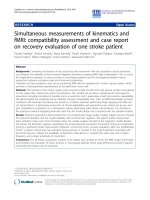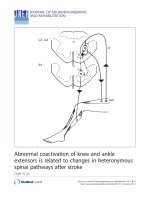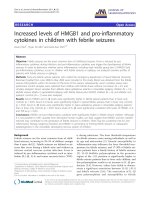báo cáo hóa học:" Health-related quality of life and migration: A cross-sectional study on elderly Iranians in Sweden" ppt
Bạn đang xem bản rút gọn của tài liệu. Xem và tải ngay bản đầy đủ của tài liệu tại đây (256.56 KB, 8 trang )
BioMed Central
Page 1 of 8
(page number not for citation purposes)
Health and Quality of Life Outcomes
Open Access
Research
Health-related quality of life and migration: A cross-sectional study
on elderly Iranians in Sweden
Afsaneh Koochek*
1
, Ali Montazeri
†2
, Sven-Erik Johansson
†1
and
Jan Sundquist
†1,3
Address:
1
Center for Family and Community Medicine, Karolinska Institute, Huddinge, Sweden,
2
Iranian Institute for Health Sciences Research,
Tehran, Iran and
3
Stanford Prevention Research Center, Stanford University School of Medicine, California, USA
Email: Afsaneh Koochek* - ; Ali Montazeri - ; Sven-Erik Johansson - ;
Jan Sundquist -
* Corresponding author †Equal contributors
Abstract
Background: Although elderly Iranian immigrants in Sweden are the largest elderly group born
outside Europe, little is known about their health-related quality of life (HRQL). The aim of this
study was to examine the association between migration status and HRQL in a comparison of
elderly Iranians in Iran, elderly Iranian immigrants in Sweden, and elderly Swedes in Sweden.
Methods: The Short Form Health Survey (SF-36) was administered to a total of 625 men and
women aged 60–84 years to collect HRQL information on elderly Iranians in Sweden (n = 176) and
elderly Iranians in Iran (n = 298). A Swedish control group (n = 151) was also randomly selected
from the general population. Multiple linear regression procedures were applied to analyze data
while adjusting for age, which was categorized into 60–69, and 70–84 years, and education.
Results: Iranian women in Sweden with shorter times of residence scored lower on vitality (β-
coefficient = -7.9, 95% CI = -14.3 to -1.5) compared with other women in this study. The lower
vitality dimension score remained nearly unchanged in the main model (β-coefficient = -7.3, 95%
CI = -13.7 to -0.9). A longer period of residence in Sweden had a positive association with social
functioning (β-coefficient = 14.1, 95% CI = 3.1–25.1) and role limitation due to emotional problems
(β-coefficient = 18.3, 95% CI = 1.4–35.2) among elderly Iranian women. In general, the Swedish
subsample scores higher on all dimensions of the SF-36 among women and in six out of eight among
men in relation to the rest of the subsamples.
Conclusion: The HRQL of elderly Iranians in Sweden was more like that of their countrymen in
Iran than that of Swedes, who reported a better HRQL than Iranians in this study. However, length
of time since migration to Sweden is not associated with poorer HRQL among elderly Iranians. The
association varied, however, with sex. Elderly Iranian women showed an increase in two of eight
dimensions of the SF-36 with additional years in Sweden, whereas, among elderly Iranian men,
additional years in Sweden were not associated with HRQL.
Published: 23 November 2007
Health and Quality of Life Outcomes 2007, 5:60 doi:10.1186/1477-7525-5-60
Received: 1 June 2007
Accepted: 23 November 2007
This article is available from: />© 2007 Koochek et al; licensee BioMed Central Ltd.
This is an Open Access article distributed under the terms of the Creative Commons Attribution License ( />),
which permits unrestricted use, distribution, and reproduction in any medium, provided the original work is properly cited.
Health and Quality of Life Outcomes 2007, 5:60 />Page 2 of 8
(page number not for citation purposes)
Background
Despite the fact that the elderly Iranian immigrants in
Sweden are the largest elderly group born outside of
Europe [1], research findings on their health-related qual-
ity of life (HRQL) are scarce. This is an important public
health issue because the proportion of elderly immigrants
in Sweden is increasing and cardiovascular disease (CVD)
is one of the main causes of morbidity and mortality
among older people [2,3]. Moreover, the increase in the
prevalence of CVD in the elderly can lead to impairment
of the HRQL [4]. This becomes even more important on
considering that most of the immigrants in Sweden live
longer than their fellow-countrymen in the native country
[5] and a longer life expectancy prolongs the duration of
exposure to risk factors and results in an elevated risk of
CVD clinical events and also of other chronic disorders.
Recent studies on migration and health tend to focus on
risk factors for CVD in younger generations [6-8] and have
demonstrated that the length of time since migration is
associated with a high prevalence of a disadvantageous
risk factor profile. Moreover, a small number of studies
have investigated the health of elderly immigrants in Swe-
den and shown that foreign-born elderly individuals
report poorer health than native-born ones [9,10]. These
findings raise the question of whether the observed health
disadvantages among elderly immigrants reflect differ-
ences in the underlying health status of people from the
country of origin, in the new country, or are related to the
time of residence in the new country. We studied this
question comparing two groups of older Iranian immi-
grants with shorter and longer times of residence in Swe-
den with similar, non-migrant Iranians in Iran and the
general aging population in Sweden.
This study was aimed at bridging the gap in knowledge by
examining whether there is an association between migra-
tion status, i.e. being an elderly Iranian in Iran, an elderly
Iranian immigrant in Sweden, or an elderly Swede in Swe-
den, and the health-related quality of life. Additionally,
we wished to examine whether the length of time since
migration to Sweden is associated with the HRQL, taking
into account the variables age and education.
Methods
Measure of health-related quality of life
We used the Short Form Health Survey (SF-36) to measure
the quality of life. This is a well-known general instrument
for measuring the health-related quality of life that is
available both in Farsi (the Iranian language) and Swedish
[11,12]. The SF-36 measures eight health-related con-
cepts: physical functioning (PF-10 items), role limitations
due to physical problems (RP-4 items), bodily pain (BP-2
items), general health perceptions (GH-5 items), vitality
(VT-4 items), social functioning (SF-2 items), role limita-
tions due to emotional problems (RE-3 items), and per-
ceived mental health (MH-5 items). The first four
dimensions are related to physical health, while the last
four are related to mental health. The areas cover activities
of daily living, emotional state, pain, fatigue, social partic-
ipation, and perceptions of health. In addition, a single
item that provides an indication of a perceived change in
the general health status over a one-year period (health
transition) is also included in the SF-36. The items can be
summed up to give scores of 0–100. A higher score indi-
cates a better HRQL for a particular area [12].
The Iranian version of SF-36, which had previously been
translated into Farsi and validated [11], was administered
to the Iranian group in this study. The Iranian version was
produced in the International Quality of Life Assessment
(IQOLA) Project to match the original SF-36 from the
United States of America.
The study population
All Iranian-born persons aged 60–84 who resided in the
township of Kista, Stockholm (n = 286), were invited to
participate in the study via a letter written in both Swedish
and Farsi. One hundred and seventy-six persons (65%)
agreed to participate in the study. Interviews were con-
ducted face-to-face in the participants' native language,
Farsi, using a questionnaire based on material produced
for the Swedish Annual Level of Living Survey by Statistic
Sweden.
The non-response analysis of the Iranian group in Sweden
was conducted by telephone. In total, 16 women and 5
men were contacted in this way. There were no significant
differences between the respondents and non-respond-
ents with regard to sex, education, and self-reported
health. However, the non-respondents were slightly older
(p < 0.05) (mean age ± SD = 72.8 ± 7.7 years) than the par-
ticipants (mean age ± SD = 70.5 ± 7.0 years).
Power
The original sample size was calculated to detect a mini-
mum differences of 6.5 (SD = 21) units in general health
(SF-36) between elderly Iranian immigrants in Sweden
and non-migrant groups in Iran and Sweden with an α =
0.05 and a statistical power of 80%. In addition, we also
anticipated a 40% non-response rate for the Iranian-born
group in Sweden and determined that the recruitment
goal would be 175 participants in the Iranian immigrant
group. The Swedish-born group was matched for age and
sex and the Iranian group in Iran was matched for age.
The Iranian group in Iran consisted of 298 randomly sam-
pled healthy Iranian-born persons aged 60–84, living in
22 urban districts in Tehran, who were selected using a
stratified multi-stage area sampling procedure. The
Health and Quality of Life Outcomes 2007, 5:60 />Page 3 of 8
(page number not for citation purposes)
response rate in this sample was 87%. A team of trained
interviewers collected data and all participants were inter-
viewed in their home [11].
The SF-36 score of each of the Iranian groups in Iran and
Sweden was matched with the Swedish population norms
for sex and age (n = 151), which were randomly drawn
from the Swedish SF-36 national normative database (n =
8930) [12].
Independent variables
Age was categorized into the following age groups: 60–69
and 70–84.
Migration status was defined as Iranians in Iran, Iranians in
Sweden, or Swedes. In addition, the Iranian group in Swe-
den was further divided according to time of residence in
Sweden, which was based on the self-reported calendar
year when the Iranian participant immigrated to Sweden.
Thus, the Iranians were categorized as either "immigrated
in 1988 or earlier" or "immigrated in 1989 or later". This
categorization was performed since previous research has
demonstrated an association between time in Sweden and
risk factors for CVD [7]. The cut-off point, 1988–89, was
chosen in order to obtain two groups of uniform size.
Education was used as an indicator of socioeconomic sta-
tus and the participants were classified into two catego-
ries: (1) ≤ 9 years of education and (2) > 9 years of
education.
Statistical analysis
Scores for the eight dimensions were coded, summed up,
and ranked on a scale from 0 (worst possible health) to
100 (best possible health) by means of the SAS software
package, using the method described in the user manual
[12] and are reported for the two sexes and for each of the
eight dimensions. The SF-36 scores (continuous) were
analyzed by multiple linear regressions using STAT soft-
ware [13]. The following reference categories were chosen:
Iranians in Iran (migration status), 60–69 years (age), and
≤9 years (education). By definition, the reference group
has a β-estimate of zero so that the value of the β-coeffi-
cient corresponds to the difference in scores for each
dimension and category compared to the reference cate-
gory. The results are shown as β-coefficients with 95%
confidence intervals (CIs).
If repeated random samples
are drawn and a 95% confi-
dence interval for the estimated parameter is constructed
for each sample, 95% of all intervals will contain the
unknown (true) parameter μ. In our study we estimated β-
coefficients, which indicate that if the CI contains zero,
the β-coefficients are non-significant.
Two models were taken into consideration: the first one
was unadjusted (crude model) and the second one (main
model) was adjusted for age and education.
Ethical considerations
This study was approved by the Karolinska Institute's Eth-
ics Committee, Reg. No. 92/03, March 10, 2003. All par-
ticipants in the Iranian group in Sweden gave their
informed consent to participate in the study. There was no
risk of identification of the participants in this study
because names and personal identification numbers were
deleted before the analysis started. All personal registra-
tion numbers have been replaced by serial numbers. The
use of the research database is restricted on the conditions
of the highest security. Only the main author has access to
the data. All data will be presented as group data without
any possibility of identifying individuals.
Results
The characteristics of the study sample by migration status
and sex are shown in Table 1. The numbers of women
Table 1: Characteristics of the study sample (values are numbers, with percentages given in parentheses)
Migration status
Iranians in Iran Iranians in Sweden Swedes
Immigrated in 1989 or later Immigrated in 1988 or
before
Variable Level Men
n = 147
Women
n = 151
Men
n = 27
Women
n = 70
Men
n = 29
Women
n = 50
Men
n = 49
Women
n = 102
Age 60 – 69 years 79 (54%) 93 (62%) 16 (60%) 34 (49%) 13 (45%) 24 (48%) 30 (61%) 57 (56%)
70 – 84 years 68 (46%) 58 (38%) 11 (40%) 36 (51%) 16 (55%) 26 (52%) 19 (39%) 45 (44%)
Mean age ±
SD (years)
68.9 ± 6.6 67.0 ± 5.9 69.3 ± 5.2 70.2 ± 7.2 70.2 ± 6.9 70.8 ± 7.7 67.9 ± 6.0 68.6 ± 6.9
Education > 9 years 48 (33%) 15 (10%) 18 (66%) 13 (19%) 21 (72%) 19 (38%) 11 (22%) 24 (24%)
≤ 9 years 99 (67%) 136 (90%) 9 (33%) 57 (81%) 8 (28%) 31 (62%) 38 (78%) 75 (76%)
Health and Quality of Life Outcomes 2007, 5:60 />Page 4 of 8
(page number not for citation purposes)
were higher among Iranians in Sweden and Swedes (120
and 102, respectively) than those of men (56 and 49,
respectively) from the same groups and they were slightly
older than the men. Iranians who immigrated to Sweden
in 1988 or earlier were more educated than other groups
in this study, whereas Iranian women in Iran were less
educated (90%).
The mean scores and standard deviation of the SF-36
dimension scores by migration status are presented in Fig-
ures 1a and 1b for men and women, respectively.
The findings in the crude model indicate that Iranian
women in Sweden with a shorter time of residence scored
a lower HRQL than Iranian women in Iran on six of eight
dimensions of the SF-36. However, only the score for
vitality was significantly lower (β-coefficient = -7.9, 95%
CI = -14.3–1.5) and remained nearly unchanged after
adding the effect of age and education in the main model
(β-coefficient = -7.3, 95% CI = -13.7–0.9) (Table 2). Fur-
thermore, a longer time of residence in Sweden was more
likely to have a positive effect on all of the SF-36 subscales
among elderly Iranian women. Additional analysis
showed that these positive effects were statistically signif-
icant for social functioning (β-coefficient = 14.1, 95% CI
= 3.1–25.1) and role limitation due to emotional prob-
lems (β-coefficient = 18.3, 95% CI = 1.4–35.2) and just
slightly significant for role limitations due to physical
problems (β-coefficient = 14.6, 95% CI= -0.4–29.6) after
adjusting for age and education (data are not shown but
are available from the corresponding author).
The dimensions assessing role limitations due to physical
problems, general health perceptions, social functioning,
role limitations due to emotional problems, and mental
health showed better outcomes for Iranian women with a
longer time of residence compared with Iranian women in
Iran. However, only the β-coefficients for social function-
ing and role limitations due to emotional problems were
significantly higher in the crude model. The β-coefficient
for social functioning remained significantly higher even
after adjusting for age and education in the main model
(Table 2). Swedish women in this study score higher on
all dimensions of the SF-36 in relation to Iranian women.
Swedish men scored higher for physical function, role
limitations due to physical problems, general health per-
ceptions, social functioning, role limitations due to emo-
A: Unadjusted mean scores and confidence interval for SF-36 dimension scores by migration status for men. B: Unadjusted mean scores and confidence interval for SF-36 dimension scores by migration status for women.Figure 1
A: Unadjusted mean scores and confidence interval for SF-36 dimension scores by migration status for men. B: Unadjusted
mean scores and confidence interval for SF-36 dimension scores by migration status for women.
Health and Quality of Life Outcomes 2007, 5:60 />Page 5 of 8
(page number not for citation purposes)
tional problems, and perceived mental health in relation
to Iranian men.
Discussion
The main finding of this study was that, in general, the
HRQL of elderly Iranians in Sweden did not decrease with
the time of residence according to dimensions of the SF-
36. However, the results of examining whether the length
of time since migration to Sweden is associated with
HRQL showed few significant differences. Another find-
ing was that the mean scores of HRQL for both Iranian
groups were lower than those of the Swedish general pop-
ulation in all dimensions among women and in six of
eight dimensions among men. Moreover, the finding
indicated that the association between the length of time
since migration to Sweden and HRQL varied with sex. Eld-
erly Iranian women with a shorter time of residence in
Sweden reported a lower vitality than Iranian women in
Iran. Nevertheless, the social functioning and role limita-
tion due to emotional problems increased with additional
Table 2: β-coefficient and 95% confidence interval (CI) for SF-36 dimensions in two models
Variable Crude model Main model (adjusted for age and
education)
Women Men Women Men
PF
Iranians in Iran 0 (Reference) 0 (Reference) 0 (Reference) 0 (Reference)
Iranians in Sweden 1989- -5.1 (-12.7 – 2.6) 2.8 (-7.8 – 13.5) -3.3(-10.7 – 4.1) -0.5(-11.2 – 10.1)
Iranians in Sweden -1988 0.2 (-8.4 – 8.9) -1.4 (-11.5 – 8.8) 1.4 (-7.3 – 10.0) -4.4 (-14.5 – 5.6)
Swedes 22.7 (15.7 – 29.6) 10.7 (2.2 – 19.2) 23.6 (16.8 – 30.4) 10.6 (2.4 – 18.8)
RP
Iranians in Iran 0 (Reference) 0 (Reference) 0 (Reference) 0 (Reference)
Iranians in Sweden 1989- -7.8 (-18.9 – 3.6) 11.7 (-6.0 – 29.4) -7.5 (-18.7 – 3.6) 2.3 (-15.3 – 19.9)
Iranians in Sweden -1988 9.9 (-2.7 – 22.4) 0 (-17 – 16.9) 7.9 (-5.2 – 20.9) -7.3 (-23.6 – 9.3)
Swedes 40.4 (30.2 – 50.5) 19.0 (4.8 – 33.1) 40.9 (30.7 – 51.2) 19.0 (5.4 – 32.5)
BP
Iranians in Iran 0 (Reference) 0 (Reference) 0 (Reference) 0 (Reference)
Iranians in Sweden 1989- -6.3 (-14.6 – 1.9) -1.9 (-14.8 – 11.1) -7.1 (-15.5 – 1.2) -6.0 (-19.2 – 7.2)
Iranians in Sweden -1988 0.16 (-9.2 – 9.5) -1.1 (-13.3 – 11.0) -1.8 (-11.6 – 7.9) -3.6 (-15.9 – 8.7)
Swedes 18.9 (11.5 – 26.3) 3.8 (-6.1 – 13.7) 18.8 (1.3 – 26.3) 3.6 (-6.0 – 13.3)
GH
Iranians in Iran 0 (Reference) 0 (Reference) 0 (Reference) 0 (Reference)
Iranians in Sweden 1989- 0.8 (-5.2 – 6.7) 7.7 (-1.6 – 17.0) 0.6 (-5.4 – 6.6) 5.3 (-4.2 – 14.8)
Iranians in Sweden -1988 6.2 (-0.5 – 12.8) 4.1 (-4.6 – 12.8) 5.0 (-2.0 – 12.3) 1.7 (-7.2 – 10.6)
Swedes 21.6 (16.2 – 27.0) 12.4 (4.8 – 20.0) 21.4 (16.0 – 26.9) 13.1 (5.6 – 20.5)
VT
Iranians in Iran 0 (Reference) 0 (Reference) 0 (Reference) 0 (Reference)
Iranians in Sweden 1989- -7.9 (-14.3 – -1.5) 5.9 (-3.1 – 14.8) -7.3 (-13.7 – -0.9) 3.6 (-5.6 – 12.8)
Iranians in Sweden -1988 -1.3 (-8.5 – 5.9) 6.4 (-2.0 – 14.8) -1.6 (-9.0 – 5.9) 6.5 (-2.0 – 15.1)
Swedes 21.2 (15.4 – 27.0) 5.0 (-2.0 – 12.1) 21.2 (15.4 – 27.0) 3.9 (-3.0 – 10.9)
SF
Iranians in Iran 0 (Reference) 0 (Reference) 0 (Reference) 0 (Reference)
Iranians in Sweden 1989- 3.7 (-4.1 – 11.5) 3.6 (-7.6 – 14.9) 4.0 (-4.0 – 12.0) 2.1 (-9.6 – 13.8)
Iranians in Sweden -1988 18.3 (9.5 – 27.1) 6.2 (-4.3 – 16.8) 18.6 (9.3 – 27.9) 4.8 (-6.2 – 15.7)
Swedes 34.1 (27.2 – 41.1) 23.6 (15.0 – 32.2) 35.2 (28.0 – 42.3) 23.7 (15.1 – 32.3)
RE
Iranians in Iran 0 (Reference) 0 (Reference) 0 (Reference) 0 (Reference)
Iranians in Sweden 1989- -5.8 (-18.1 – 6.4) -5.2 (-23.3 – 13.0) -8.3 (-20.9 – 3.7) -8.0 (-27.0 – 10.9)
Iranians in Sweden -1988 14.5 (0.5 – 28.5) 4.1 (-13.2 – 21.4) 9.7 (-4.9 – 24.2) 1.7 (-16.1 – 19.6)
Swedes 37.5 (26.3 – 48.7) 21.7 (7.3 – 36.1) 37.2 (25.8 – 48.6) 21.7 (7.2 – 36.1)
MH
Iranians in Iran 0 (Reference) 0 (Reference) 0 (Reference) 0 (Reference)
Iranians in Sweden 1989- -3.9 (-9.6 – 1.9) 1.2 (-6.8 – 9.1) -4.6 (-10.5 – 1.2) 0.8 (-7.5 – 9.1)
Iranians in Sweden -1988 2.5 (-4.0 – 8.9) 3.8 (-3.8 – 11.4) 1.0 (-5.8 – 7.8) 4.1 (-3.7 – 11.9)
Swedes 23.4 (18.2 – 28.6) 16.7 (10.2 – 23.1) 22.8 (17.5 – 28.2) 16.5 (10.0 – 22.9)
PF = physical functioning, RP = role limitations due to physical problems, BP = bodily pain, GH = general health perceptions, VT = vitality, SF =
social functioning, RE = role limitations due to emotional problems, MH = perceived mental health
Health and Quality of Life Outcomes 2007, 5:60 />Page 6 of 8
(page number not for citation purposes)
years in the new country. In contrast, among elderly Ira-
nian men, additional years in Sweden were not associated
with HRQL.
Our observation that the elderly Iranian immigrants
reported poorer health than Swedes agreed with other
studies which have confirmed that foreign-born elderly
individuals report poorer health than native-born elderly
individuals [9,10]. The finding that elderly Iranian
women with a shorter time of residence in Sweden had an
impaired vitality compared to Iranian women in Iran
agreed in part with Bentham's theory [14], which identi-
fied poor health as a reason for migration to a new coun-
try among elderly people in order to be closer to their
families. Meanwhile, the fact that this group of immigrant
women is more likely not to experience a poorer HRQL
with additional years in Sweden is not in accord with
Findley's study [15], which claims that elderly persons
with poor health will be more likely to experience addi-
tional impairment of their health after migration.
Possible pathways
In this study, the HRQL of elderly Iranians in Sweden was
more like that of their countrymen in Iran than that of
Swedes. For this reason, we argue that the observed lower
HRQL among elderly Iranian immigrants, compared to
elderly Swedes, reflects the underlying status of HRQL
among people from the country of origin. On the other
hand, the finding that length of time since migration to
Sweden has no negative effect on health may possibly be
due to a quite new migration pattern observed in elderly
immigrants in Sweden, which is characterized by travel-
ling between Sweden and their country of origin, spend-
ing long periods of time in each country. This new
migration pattern has enabled elderly Iranians to succeed
in taking advantage of the best of their original culture
and the host country's culture [16].
The higher HRQL among elderly Swedes in this study may
be due to potential cross-cultural differences in the per-
ception of health, i.e. differences in perceived health or
disease prevalence. In a population-based cross-sectional
study from the 2001 California Health Interview Survey,
it was estimated that differences in self-reported overall
health between different ethnic groups may be due to dif-
ferent perceptions of health that are rooted in culture and
language [17]. Moreover, individuals living in different
cultural environments with the same disease may perceive
their disease differently, which might affect the quality of
life in a different way [18]. However, the extent to which
cultural differences between elderly Iranians and Swedes
influence the reported HRQL is not clear.
The finding of low vitality among Iranian women with a
shorter period of residence in Sweden is alarming and
might reflect the multiple health problems and high prev-
alence of CVD risk factors among Iranian women in Iran,
which has been documented in many studies [19-25].
However, according to Bentham's theory [14], poor vital-
ity due to a high prevalence of chronic diseases, such as
CVD, might have been a reason for these women to
migrate to Sweden.
Method discussion
Socioeconomic status can be measured in different ways,
although it is not possible to measure its full dimensions.
In the current study, education was used only as a crude
proxy of socioeconomic status. At first, we considered
using income to characterize socioeconomic status. How-
ever, since 76% of the participants arrived in Sweden
when they were 50 years of age or older they were not eli-
gible for a full pension and therefore have very low
incomes. Because of their limited pension rights and
dependency on welfare aid, income is a blunt tool to dif-
ferentiate individuals by socioeconomic status.
Even using occupation as an indicator of socioeconomic
status seems to be less valid in this group of immigrants
because nearly all of them are at the age of retirement. In
addition, many immigrants in Sweden work in low-status
jobs even though they have university degrees. Therefore,
education was considered to be a more stable indicator of
socioeconomic status in this particular group. Further-
more, education as a measure of socioeconomic status
remains fairly unaffected over the course of life and the
health status. In addition, health status may influence
income and occupation, but not educational status.
One might argue, however, that a sample from Tehran is
not necessarily representative of the entire country. In
general, this is true, but since Tehran has became a multi-
cultural metropolitan area it has been suggested that a
sample from the general population in Tehran could at
least be regarded as a representative sample of an urban
population in Iran [11]. Regarding the Iranian sample in
Stockholm, we studied a population-based representative
sample of elderly Iranians in Kista/Stockholm and expect
that the result would be generalizable to similar groups
residing in other counties in Sweden. However, this expec-
tation remains to be tested.
Limitations and strengths
Some important limitations must be considered when
interpreting the results of this study. First, given the cross-
sectional nature of the results, the interpretation of the
impact of migration on the HRQL is restricted. Future
research with a longitudinal approach would be valuable
in the area of migrant studies, but very difficult to per-
form.
Health and Quality of Life Outcomes 2007, 5:60 />Page 7 of 8
(page number not for citation purposes)
The second limitation arises from the fact that we did not
control for potentially confounding factors based on
objective health status measures, e.g. weight, height, waist
measurements, blood pressure, smoking, etc., in our anal-
ysis. These measurements are important to consider
because of the accumulative prevalence of CVD risk fac-
tors in migrant and Iranian populations, particularly in
Iranian women. However, objective health status meas-
urements were not available in the data.
Finally, there is a lack of important variables such as
social, ethnic, and cultural contexts in either the Stock-
holm sample or the Iranian sample. Although no previous
study has documented an association between ethnicity,
culture, and quality of life in Iranian people, we believe
that the lack of an analysis of these variables in the results
is an important limitation.
Despite the limitations, the present study has some
strengths. Although the number of elderly Iranians in
Sweden in the study is small, we had sufficient (80%) sta-
tistical power to detect medium-sized effects. Moreover,
the well-defined control group, which constitutes a ran-
dom sample of the Swedish population, is also a strength.
Although investigating differences in the HRQL of the two
sexes was not one of the aims of this study, it is an impor-
tant topic that future research can focus on. However,
strategies and policies should include a special focus on
recently arrived elderly female immigrants who showed a
lower HRQL in some of the dimensions, compared to the
other elderly Iranian immigrant women and to elderly Ira-
nian women in Iran.
Conclusion
In conclusion, this study suggests that length of time since
migration to Sweden is not associated with a poorer
health-related quality of life among elderly Iranians; how-
ever, the effect varied with sex. Elderly Iranian women
showed an increase in two dimensions of the SF-36 with
additional years in Sweden, whereas, among elderly Ira-
nian men, additional years in Sweden were not associated
with HRQL.
The Swedish general population reported a better HRQL
than Iranians in this study, which may be due to potential
cross-cultural differences in the perception of health, i.e.,
differences in perceived health or disease prevalence. Our
results have practical implications for the health of elderly
immigrants and particularly recently arrived elderly immi-
grant women.
Abbreviations
PF: Physical functioning;
RP: Role limitations due to physical problems;
BP: Bodily pain;
GH: General health perceptions;
VT: Vitality;
SF: Social functioning;
RE: Role limitations due to emotional problems;
MH: Perceived mental health.
Competing interests
The author(s) declare that they have no competing inter-
ests.
Authors' contributions
AK is the corresponding author of the manuscript. She
contributed as a principal researcher and writer, including
drafting of the article and the analysis and interpretation
of the data.
AM contributed material on the Iranian population in
Tehran. He has made substantial contributions to the
interpretation of the data.
SEJ participated in the design of the study and performed
the statistical analysis.
JS made contributions to the design, acquisition, and
interpretation of the data and participated in the writing
process by commenting on the manuscript. He gave final
approval of the version to be published
All authors read and approved the final manuscript.
Acknowledgements
This study was supported by grants 20050936 and LS 0509-1436 from the
Stockholm County Council.
References
1. Foreign-born persons in Sweden by country of birth, age and
sex. Year 2000–2005 2006 [ />makro/Produkt.asp?produktid=BE0101]. (In Swedish: Utrikes födda
i riket efter födelseland, ålder och kön. År 2000–2005)
2. Butler J, Rodondi N, Zhu Y, Figaro K, Fazio S, Vaughan DE, Satterfield
S, Newman AB, Goodpaster B, Bauer DC, et al.: Metabolic syn-
drome and the risk of cardiovascular disease in older adults.
J Am Coll Cardiol 2006, 47:1595-1602.
3. Gerber Y, Jacobsen SJ, Frye RL, Weston SA, Killian JM, Roger VL:
Secular trends in deaths from cardiovascular diseases: a 25-
year community study. Circulation 2006, 113:2285-2292.
4. Sullivan PW, Ghushchyan V, Wyatt HR, Wu EQ, Hill JO: Impact of
cardiometabolic risk factor clusters on health-related quality
of life in the U.S. Obesity (Silver Spring) 2007, 15:511-521.
5. Nilson Å: Long life in Sweden. Demographic report. (In Swedish:
Långt liv i Sverige) Stockholm: Statistics Sweden Report No.: 2004:3 .
Publish with BioMed Central and every
scientist can read your work free of charge
"BioMed Central will be the most significant development for
disseminating the results of biomedical research in our lifetime."
Sir Paul Nurse, Cancer Research UK
Your research papers will be:
available free of charge to the entire biomedical community
peer reviewed and published immediately upon acceptance
cited in PubMed and archived on PubMed Central
yours — you keep the copyright
Submit your manuscript here:
/>BioMedcentral
Health and Quality of Life Outcomes 2007, 5:60 />Page 8 of 8
(page number not for citation purposes)
6. Kaplan MS, Huguet N, Newsom JT, McFarland BH: The association
between length of residence and obesity among Hispanic
immigrants. Am J Prev Med 2004, 27:323-326.
7. Lindstrom M, Sundquist K: The impact of country of birth and
time in Sweden on overweight and obesity: a population-
based study. Scand J Public Health 2005, 33:276-284.
8. Vissandjee B, Desmeules M, Cao Z, Abdool S, Kazanjian A: Integrat-
ing Ethnicity and Migration As Determinants of Canadian
Women's Health. BMC Womens Health 2004, 4(Suppl 1):S32.
9. Pudaric S, Sundquist J, Johansson SE: Country of birth, instrumen-
tal activities of daily living, self-rated health and mortality: a
Swedish population-based survey of people aged 55–74. Soc
Sci Med 2003, 56:2493-2503.
10. Silveira E, Skoog I, Sundh V, Allebeck P, Steen B: Health and well-
being among 70-year-old migrants living in Sweden – results
from the H 70 gerontological and geriatric population stud-
ies in Goteborg. Soc Psychiatry Psychiatr Epidemiol 2002, 37:13-22.
11. Montazeri A, Goshtasebi A, Vahdaninia M, Gandek B: The Short
Form Health Survey (SF-36): translation and validation
study of the Iranian version. Qual Life Res 2005, 14:875-882.
12. Sullivan M, Karlsson J, Ware JE Jr: The Swedish SF-36 Health Sur-
vey – I. Evaluation of data quality, scaling assumptions, relia-
bility and construct validity across general populations in
Sweden. Soc Sci Med 1995, 41:1349-1358.
13. StataCorp: Stata Statistical Software. 7.0th edition. Texas: Stata
press; 2001.
14. Bentham G: Migration and morbidity: implications for geo-
graphical studies of disease. Soc Sci Med 1988, 26:49-54.
15. Findley SE: The directionality and age selectivity of the health-
migration relation: evidence from sequences of disability and
mobility in the United States. Int Migr Rev 1988, 22:4-29.
16. Ahmadi F, Tornstam L: The old flying Dutchmen: Scuttling
immigrants with double assets. Journal of Aging and Identitiy 1996,
1:191-210.
17. Kandula NR, Lauderdale DS, Baker DW: Differences in self-
reported health among asians, latinos, and non-Hispanic
whites: the role of language and nativity. Ann Epidemiol 2007,
17:191-198.
18. Faresjo A, Anastasiou F, Lionis C, Johansson S, Wallander MA, Faresjo
T: Health-related quality of life of irritable bowel syndrome
patients in different cultural settings. Health Qual Life Outcomes
2006, 4:21.
19. Kaldi AR: A study on physical, social and mental problems of
the elderly in district 13 of Tehran. Age Ageing 2004, 33:322.
20. Azizi F, Ainy E: Coronary heart disease risk factors and meno-
pause: a study in 1980 Tehranian women, the Tehran Lipid
and Glucose Study. Climacteric 2003, 6:330-336.
21. Azizi F, Rahmani M, Emami H, Mirmiran P, Hajipour R, Madjid M,
Ghanbili J, Ghanbarian A, Mehrabi Y, Saadat N, et al.: Cardiovascu-
lar risk factors in an Iranian urban population: Tehran lipid
and glucose study (phase 1). Soz Praventivmed 2002, 47:408-426.
22. Azizi F, Emami H, Salehi P, Ghanbarian A, Mirmiran P, Mirbolooki M,
Azizi T: Cardiovascular risk factors in the elderly: the Tehran
Lipid and Glucose Study. J Cardiovasc Risk 2003, 10:65-73.
23. Ghassemi H, Harrison G, Mohammad K: An accelerated nutrition
transition in Iran. Public Health Nutr 2002, 5:149-155.
24. Maddah M, Chinikar M, Hoda S: Iranian women with coronary
artery disease: not behind of the men. Int J Cardiol 2007,
115:103-104.
25. Bahrami H, Sadatsafavi M, Pourshams A, Kamangar F, Nouraei M,
Semnani S, Brennan P, Boffetta P, Malekzadeh R: Obesity and
hypertension in an Iranian cohort study; Iranian women
experience higher rates of obesity and hypertension than
American women. BMC Public Health 2006, 6:158.
